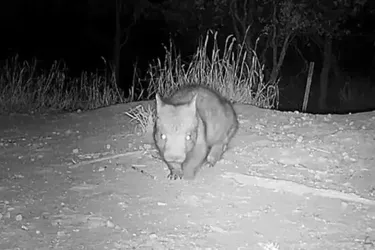Only 400 individuals: one of the rarest mammals on Earth spotted in Australian park (video)

The Earth is home to a huge number of species, including some very rare ones. A chance encounter with such creatures is a real success. One of these rare species is the northern hairy wombat.
Ecologists were amazed when they saw a cub of this species on a video from a motion sensor. IFLScience writes about it.
The video was captured by a motion sensor installed by scientists from the Australian Wildlife Conservation Service (AWC) in the Richard Underwood Nature Reserve (RUNR) in southwestern Queensland. In total, the researchers watched 100 hours of video before discovering something special.
Northern furry wombats are extremely rare, numbering approximately 400 individuals, making them one of the smallest mammals in Australia. Scientists also warn that this species is on the verge of extinction: there are only three populations left - one in the Richard Underwood Nature Reserve, another in Epping Forest National Park and the third in the Powranna State Forest.
According to AWC senior field ecologist Andy Howe, the video confirms that these extremely rare wombats are still breeding in the reserve, which gives hope for their survival. The researchers emphasize that although this is not the first cub to appear in the reserve, it is the first to be spotted in the park in the last few years.
Scientists also note that the cub looks quite healthy, which indicates good nutrition and the availability of all the necessary nutrients for growth. Howe believes that the video provides a lot of information about the state of the population in the reserve and demonstrates that the wombats are in favorable conditions for reproduction.
The northern hairy wombat (Lasiorhinus krefftii) is the largest of the three Australian wombat species. These animals can reach one meter in length and weigh up to 30 kg. They are indigenous to the eucalyptus forests of Australia, much of which was destroyed in the ninth and twentieth centuries due to clearing for agricultural purposes. In addition, European colonizers actively hunted wombats, considering them pests, like the extinct Tasmanian tiger.
By the 1980s, there was only one population of wombats left in a small part of the Epping Forest, numbering just 35 individuals. To protect this endangered species, a 20-kilometer fence was erected around their habitat, helping to protect them from dingoes and other predators.
Fortunately, the population of hairy wombats is gradually but steadily recovering. According to reports, in 2024, their number in Australia increased to 400 individuals. AWC has recently received a grant of $384,000 to implement the Northern Hairy Wombat Recovery Action Plan. This project involves an integrated approach that includes fire management and improving food resources by preventing the penetration of large herbivores into areas where wombats live.
If you want to get the latest news about the war and events in Ukraine, subscribe to our Telegram channel!
